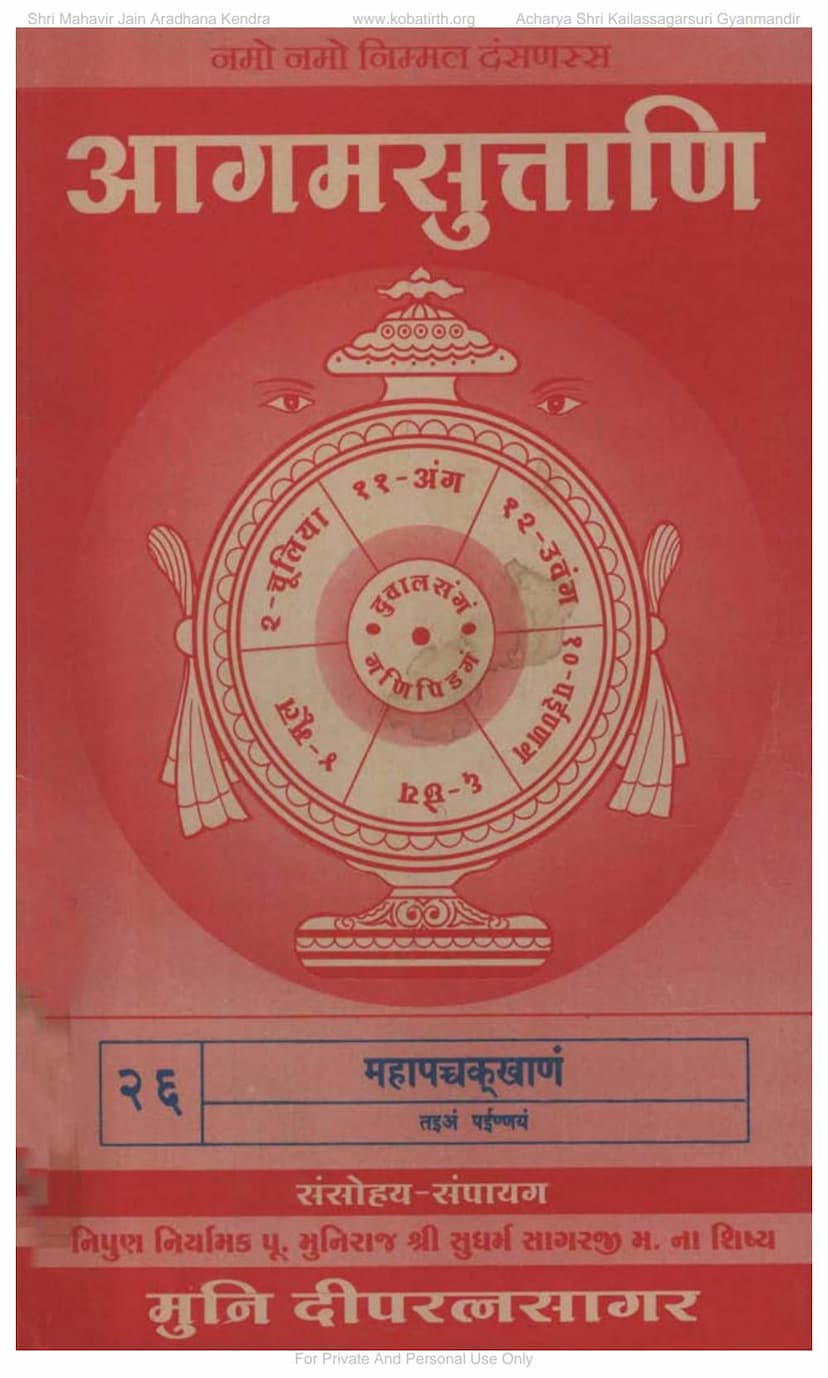Agam 26 Mahapacchakhana Painnagsutt 03 Moolam
Added to library: September 1, 2025

Summary
Here is a comprehensive summary of the Jain text "Agam 26 Mahapacchakhana Painnagsutt 03 Moolam," based on the provided pages:
This document is a Gujarati-language publication of the Jain Agam Sutra titled "Mahapachchakhana Painnayagutt," specifically the third part (Moolam) of the Painnayagutt collection. It is part of a larger series of Agam Sutras published by Agam Shrut Prakashan, with the support of various donors and under the guidance of Acharya Shri Kailassagarsuri Gyanmandir.
Key Content and Themes:
The core of this text appears to be a detailed exposition and guidance on Mahapachchakhana, which translates to "great renunciation" or "great abstention" in the context of Jainism. This concept is central to the practice of renunciation and the taking of vows. The text likely details:
- The Nature of Renunciation (Pachchakhana): It elaborates on the principles and practices of renouncing worldly possessions, desires, and harmful actions. This involves the commitment to abstaining from specific actions, foods, or behaviors, often for a set period or permanently.
- The Importance of Right Faith (Samyak Darshan): Several pages emphasize the foundational role of Right Faith in the spiritual journey. It's presented as the basis for true renunciation and the practice of vows.
- Spiritual Practices and Conduct: The text outlines various spiritual practices, including:
- Samayika: A practice of equanimity and meditation, described as tripartite (mind, speech, and body).
- Vows (Vrata): The text details the importance of taking and adhering to vows, specifically mentioning the five great vows (Mahavrata) and their rigorous observance.
- Repentance and Forgiveness (Pachchitta, Kshama): A significant portion is dedicated to the practice of acknowledging past wrongdoings, seeking forgiveness from all beings, and forgiving others. This includes confessing sins and seeking repentance from spiritual preceptors.
- Control of Senses and Passions (Indriya Samvara, Kashaya Nigraha): The text stresses the need to control the senses and overcome passions like anger, pride, delusion, and greed, which are seen as obstacles to spiritual progress.
- Mindfulness and Right Concentration: Emphasis is placed on focused and pure intentions in all actions and thoughts.
- The Self and Its True Nature: The text reflects on the eternal nature of the soul (Atma) as distinct from the perishable body and worldly possessions. It underscores the concept of the soul's inherent knowledge and perception.
- The Cycle of Birth and Death (Samsara): The arduous journey through the cycle of birth, death, and rebirth is a recurring theme, highlighting the suffering (dukkha) associated with worldly attachments. The ultimate goal is liberation from this cycle.
- The Path to Liberation (Moksha): The text guides the practitioner on the path to liberation by emphasizing the consistent practice of renunciation, vows, meditation, and the cultivation of virtuous qualities. It speaks of different levels of spiritual practice and their outcomes.
- Specific Principles of Renunciation: The text includes verses and explanations on what to renounce, how to renounce, and the significance of such renunciations for spiritual well-being. This might include dietary restrictions, renunciation of specific activities, and detachment from material possessions.
- Praise for Spiritual Teachers: The dedication and acknowledgments clearly show deep reverence for spiritual preceptors (Gurus), particularly Acharya Shri Kailassagarsuri and Munishri Deepratnasagarji, who compiled and presented this work.
Publication Details and Structure:
- Title: Agam 26 Mahapacchakhana Painnagsutt 03 Moolam
- Authorship: Compiled by Munishri Deepratnasagar, disciple of Muni Shri Sudharma Sagarji.
- Publisher: Agam Shrut Prakashan.
- Format: The document is a printed book, presented in Gujarati script. It includes:
- Invocation: Prayers to the enlightened ones and the principles of Jainism.
- Table of Contents/Index: Page 6 provides a structured index of the text's sections and verses, including "Visayanukkamo" (Subject Index), "Visisht Shabd-anukkamo" (Special Word Index), "Vishesh Nam-anukkamo" (Special Name Index), "Gathanukkamo" (Verse Index), and "Sutranukkamo" (Sutra Index).
- Main Body: Pages 7 through 16 contain the core text of the Mahapachchakhana Painnayagutt, presented in verses (Gathas) with sequential numbering.
- Notes and Appendices: Pages 17-22 include notes regarding the publication, acknowledgments of donors, and a catalog of other published works by Agam Shrut Prakashan.
Key Contributors and Supporters:
The publication acknowledges numerous individuals and families who have supported the project financially and spiritually. This reflects the collaborative nature of disseminating Jain scriptures. Prominent mentions include:
- Shri Mahavir Jain Aradhana Kendra and Acharya Shri Kailassagarsuri Gyanmandir as the guiding institutions.
- Munishri Deepratnasagar as the compiler/author.
- Munishri Sudharma Sagarji as the Guru.
- Numerous individuals and families from various cities (Vadodara, Mumbai, Madras, Ahmedabad, etc.) are listed as patrons and donors.
Overall Significance:
"Agam 26 Mahapacchakhana Painnagsutt 03 Moolam" is a vital Jain text that provides detailed spiritual guidance on the practice of renunciation, ethical conduct, and the path to spiritual liberation. It serves as a practical manual for followers of Jainism seeking to deepen their understanding and practice of these core principles. The publication highlights the ongoing effort to preserve and disseminate Jain scriptures for future generations.